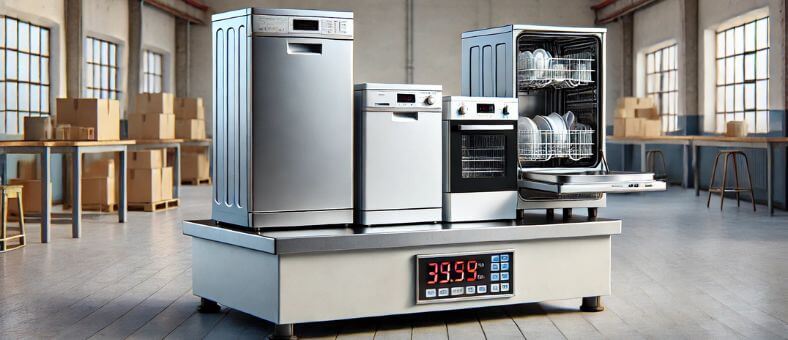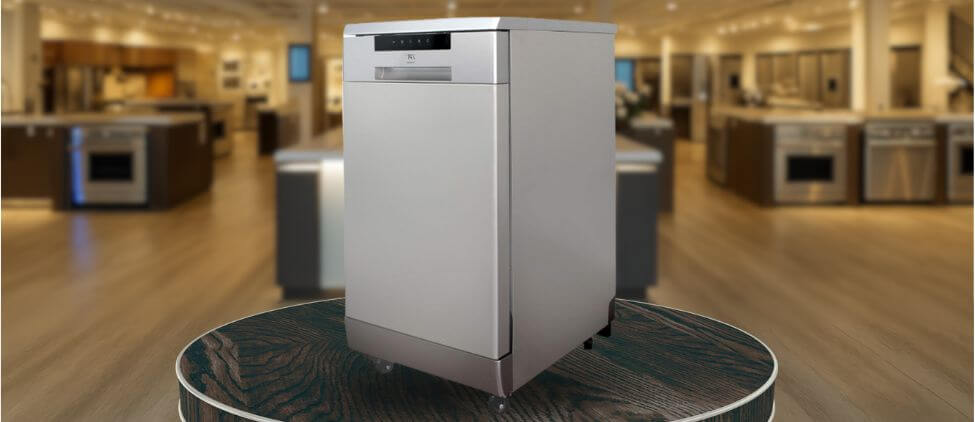Are you tired of finding leftover food on your dishes even after a wash cycle? If so, this guide on ‘How to Load Your Dishwasher Properly’ is just for you! While loading a dishwasher may seem straightforward, doing it correctly can significantly impact its performance. When done right, your dishes come out spotless, the machine lasts longer, and you can save energy. In fact, it’s like a game – you have to know where each piece goes to win the best results.
So, are you ready to make dirty dishes a thing of the past and become a master of your dishwasher? Keep reading this simple, friendly guide. Together, we’ll unlock the full potential of your dishwasher and say goodbye to those annoying food bits forever!
Table of Contents
Understanding the Top Rack Better
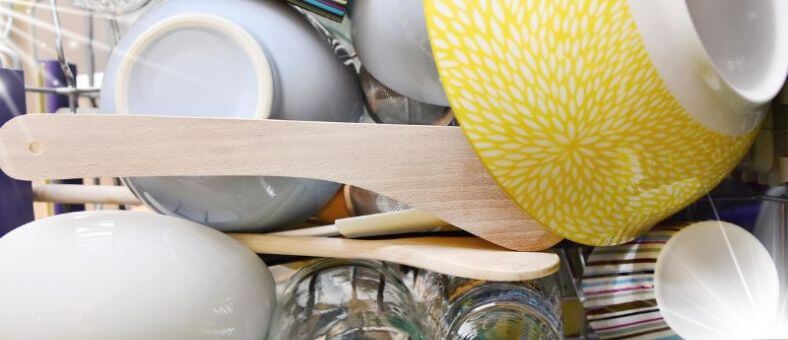
- Cups, glasses, and smaller bowls should be placed on the top rack, arranged upside down and between the tines to avoid movement and reduce the risk of chipping.
- Plastic containers are best kept on the top rack to avoid warping or melting, as the heat source in most dishwashers is at the bottom. Always check that plastics are dishwasher safe.
- For stubborn tea or coffee stains, place mugs or cups in the center of the top rack where the water spray is strongest. This will help remove stains more effectively.
- Delicate wine glasses should be carefully placed between the tines for stability. To ensure glasses remain secure during the wash cycle, use stemware holders or fold-down racks.
Getting to Know Your Bottom Rack Better

- The bottom rack is ideal for heavier, bulkier items such as dinner plates, serving dishes, and large bowls. Ensure to load these items carefully, as the bottom rack is meant for sturdier items but requires proper arrangement.
- Place plates and larger flat items in the slots facing the center, where the water spray typically emanates, ensuring even cleaning coverage.
- Angle large pots, pans, and casseroles downward in the rack to allow water to access the inside, improving cleanliness and simplifying post-meal cleanup.
- Cutlery should also be placed on the bottom rack. For safety, knives should be positioned with the sharp end downward. Spoons and forks should face upwards to allow water to reach the food-soiled parts more effectively.
- Mix spoons and forks before placing them in the utensil basket to avoid nesting and ensure thorough cleaning.
Making the Most of the Third Rack
- The third rack is shallower than the others, designed for longer, flatter utensils and smaller items that might get lost in the main compartments.
- It’s ideal for kitchen tools like spatulas, whisks, and serving spoons, which fit nicely due to their length and flat shape, allowing them to lie securely without blocking the water spray.
- Use this rack for small items such as lids, parts of baby bottles, or espresso machine cups to prevent them from getting tossed around in a regular wash cycle.
- Arranging items neatly on the third rack ensures each piece receives thorough cleaning, making it a dedicated space for delicate or small items that need careful handling.
The Third Rack’s Magic!
The third rack, often found in newer models, increases loading capacity by about 30%, making room for more dishes!
Concluding Thoughts on How to Load Your Dishwasher Properly
Alright, rockstars, ready for some mind-blowing dish magic? By using these super-cool loading tricks, your dishwasher will work harder for you and zap every last bit of grime from your dishes. But remember, brush off those big chunks of food before you load up. And don’t cram everything in – a packed dishwasher won’t clean your dishes well.
You’re stepping up your dishwashing game by being a smart loader and following these easy-peasy guidelines! No more annoying re-washes – just dazzlingly clean dishes every single time. Here’s to less tedious chores and more time enjoying the sparkle of perfectly clean dishes. Let’s make cleaning fun, champions!
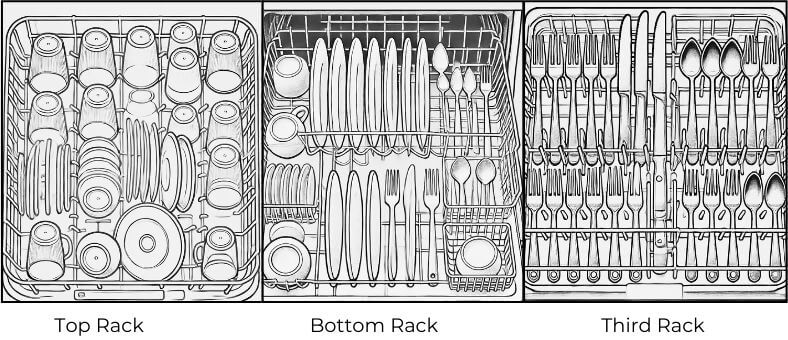
Additional Tips for Loading a Dishwasher
Alright, eager learners, now that you’ve mastered the basics of loading a dishwasher, it’s time to add some extra flavors to your dishwashing recipe. Let’s sprinkle in some more tips and tricks to ensure your dishwasher performs at its best. This is where we delve deeper, add nuances, and navigate the dishwasher-loading journey with an expert eye.
For a practical demonstration on how to properly load your dishwasher for optimal cleaning, watch this helpful video.
Pre-rinsing Dishes: Myth or Necessity?
One of the most widespread misconceptions about dishwashers involves pre-rinsing. Many believe dishes must be thoroughly rinsed before entering the dishwasher. This is, however, unnecessary in most cases. Modern dishwashers are designed to handle everyday food residue without requiring a pre-rinse.
Not only does pre-rinsing wastewater and time, but it can also lead to less efficient cleaning. Many contemporary dishwasher models use sensors to detect food particles. These sensors then adjust the wash cycle to ensure optimal cleaning. By pre-rinsing, you could be tricking your dishwasher into thinking your dishes are cleaner than they are, resulting in a less effective wash. For a more in-depth look at why pre-rinsing isn’t necessary, check out the article: Is Pre-Rinsing Necessary?
Secure Small Items: Prevent Slipping
Every household has tiny titans – small items such as bottle caps, corn cob holders, or baby’s pacifiers. These items may get lost or fall through the racks during a wash cycle, potentially damaging your dishwasher.
Consider placing these smaller items in a dishwasher-safe mesh bag or a specially designed basket to prevent this. Not only does this keep them secure during the wash, but it also makes them easier to find when unloading.
Determining How Much Detergent is Right
Too much of a good thing can lead to harm; this adage also holds true for dishwasher detergent. Overloading on detergent can leave an unsightly soap residue on your dishes, making them less clean and shiny.
Measuring your detergent according to the manufacturer’s instructions and adjusting the amount based on your water hardness and the load’s soil level is essential. And remember, detergent isn’t wine—it doesn’t get better with age. Over time, detergents can degrade and lose their effectiveness. So, buy smaller quantities you’ll use up within a few months. To ensure you’re using the best options available, discover our top picks in the 6 Best Dishwasher Detergents.
A Sneak Peek Into the Past
Dishwasher detergents debuted in the market around the mid-20th century, making dishwashing easier and quicker!
Dishwasher Timing: When to Run It for Best Results
Perhaps you haven’t thought about it previously. Still, the timing of your dishwasher cycles can impact your utility bills and the lifespan of your dishwasher. Running your dishwasher during off-peak hours, typically during the nighttime, can sometimes help you take advantage of lower energy rates. Plus, there’s something immensely satisfying about waking up to a dishwasher full of sparkling clean dishes! For more insights on optimizing your dishwasher usage, read our guide on What Is The Best Time Of Day To Run Your Dishwasher?
Regular Maintenance: Key to a Long-Lasting Dishwasher
Just like any other appliance in your home, your dishwasher requires proper maintenance to ensure it runs efficiently. Make it a monthly routine to clean your dishwasher filter. Removing accumulated food particles can significantly improve its performance.
It’s a good idea to occasionally run an empty dishwasher cycle with a specialized cleaner. This can help keep your dishwasher in good condition. This can help remove mineral buildup from the dishwasher’s inner mechanisms, improving its efficiency and lifespan.
Dish Size: Key for Dishwasher Buying
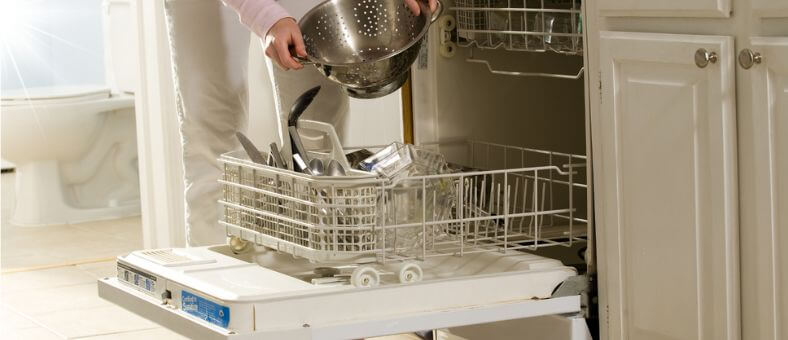
Have you ever bought a large cutting board, a beautiful baking sheet, or a large colander, only to realize they don’t fit in your dishwasher? Avoid such disappointments by considering your dishwasher’s dimensions when shopping for kitchenware. If it doesn’t fit, you’ll be stuck with the tedious task of hand washing. To ensure you choose the right size for your needs, check out our article on Choosing the Right Dishwasher Size.
Resisting Overload: Find the Right Fit
While squeezing in that last dish might be satisfying, resist the urge. Overloading your dishwasher impedes the water and detergent from circulating effectively, which can lead to fewer clean dishes. It’s best to think of your dishwasher like a jigsaw puzzle, where every piece has its place, rather than a game of Tetris where the goal is to fit as many pieces as possible.
The journey to master dishwasher loading is ongoing. By following these tips, you will achieve cleaner dishes and help prolong your dishwasher’s life. Remember, your dishwasher is there to simplify your life, not complicate it. So treat it right, and it will reward you with stellar service.
Dishwasher Magic: More Sparkle, Less Hassle!
Wow, who knew dishwashers had so many tricks up their sleeves? We bet you’re ready to put all this incredible new knowledge to work! By using these additional tips for loading your dishwasher, your dishes will sparkle like never before. Plus, you’ll be taking super good care of your dishwasher, ensuring it sticks around to clean up after your meals for a long time. So, get ready to impress everyone at home with your dishwasher skills! There’ll be less time for cleaning and more time for fun. Let’s make those chores easier and turn a tedious task into an exciting game. Dishwasher, here we come!
At WashDryDazzle, our primary goal is to equip you with invaluable knowledge to simplify your day-to-day tasks; to explore more, check out our central hub of Dishwasher Guides.
Frequently Asked Questions (FAQs)
Why does the position of dishes in the dishwasher matter?
Positioning matters because it allows optimal water flow and better cleaning. Each item must be exposed to the dishwasher’s water jets to get cleaned properly.
Can I put pots and pans in the dishwasher?
This depends on the manufacturer’s instructions for your pots and pans. Some are dishwasher safe, while others recommend hand washing. Check the instructions before loading.
Can I mix silverware in the dishwasher?
Yes, it’s recommended to mix forks, spoons, and knives to prevent them from nesting and ensure they get cleaned effectively.
Should I always load the dishwasher to full capacity before running a cycle?
While running a full load is energy efficient, you should avoid overloading. This could hinder the dishwasher’s performance and lead to poorly cleaned dishes.
Maximize Your Dishwasher’s Lifespan with Expert Tips!
Discover the crucial steps for proper usage and maintenance to ensure your dishwasher operates flawlessly for years. Our expert guidance covers best practices and routine maintenance to help you sidestep typical issues, boost efficiency, and extend the life of your appliance. Gain valuable knowledge on the best times to run your dishwasher and key regular checks to avert malfunctions and expensive repairs down the line.
Explore our comprehensive maintenance guide now and guarantee a durable, efficient dishwasher!
- 18 Common Dishwasher Mistakes You’re Likely Making Every Day!
- Why Does the Sink Fill Up When Running the Dishwasher? Exploring the 4 Possible Reasons
- What Is The Best Time Of Day To Run Your Dishwasher?
- Can I Put My Cutting Board in the Dishwasher?
- Accidentally Put Dish Soap in the Dishwasher? Solutions and Tips
Unlock the Full Potential of Your Dishwasher!
Discover the multifaceted world of modern dishwashers, an innovation hub with features designed for every need. Explore how each feature can be customized to suit your requirements, from eco-friendly modes to advanced sanitization options. Our articles will guide you through what your dishwasher can do, helping you maximize its capabilities while understanding its limits.
Embark on your journey to dishwasher mastery with us today!
- Dishwasher Air Gaps: What They Are and Why We Need Them
- Understanding the Sanitization Function in Dishwashers
- The Dishwasher’s Impact on Knives: What You Need to Know
- Portable vs. Built-in Dishwashers: Which is Better?




